

Montana-Yellowstone Geologic Field Guide Database. Introduction Field experiences are a central component of the modern geoscience curriculum, and published field guides and road logs are invaluable resources to facilitate the development of teaching and learning in the field.
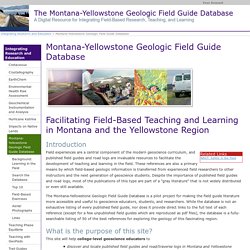
These references are also a primary means by which field-based geologic information is transferred from experienced field researchers to other instructors and the next generation of geoscience students. Despite the importance of published field guides and road logs, most of the publications of this type are part of a "gray literature" that is not widely distributed or even still available. The Montana-Yellowstone Geologic Field Guide Database is a pilot project for making the field guide literature more accessible and useful to geoscience educators, students, and researchers.
What is the purpose of this site? Use this resource! Search the Database - This page allows you to search the collection of published logs by topic, geographic location, and geologic province. Soil: The Foundation of Agriculture. Alexandratos, N.
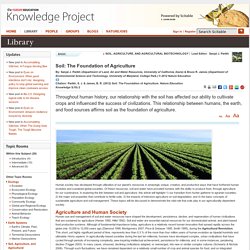
World food and agriculture: Outlook for the medium and longer term. Proceedings of the National Academy of Sciences of the United States of America 96, 5908-5914 (1999). Bernhard, A. The Nitrogen Cycle: Processes, Players, and Human Impact. Nature Education Knowledge 2, 12 (2010). What is Geology? - What does a Geologist do? - Geology.com. Definition of Geology: Geology is the study of the Earth, the materials of which it is made, the structure of those materials, and the processes acting upon them.
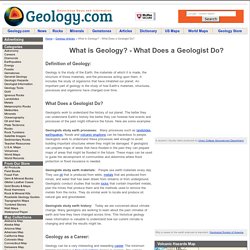
It includes the study of organisms that have inhabited our planet. An important part of geology is the study of how Earth’s materials, structures, processes and organisms have changed over time. What Does a Geologist Do? Geologists work to understand the history of our planet. Geologists study earth processes: Many processes such as landslides, earthquakes, floods and volcanic eruptions can be hazardous to people. Geologists study earth materials: People use earth materials every day. Geologists study earth history: Today we are concerned about climate change. Geology as a Career: Geology can be a very interesting and rewarding career. Geologists work in a variety of settings. Although a bachelor's degree is required for entry level employment, many geologists earn master's and/or doctorate degrees. Employment Outlook:
For Educators. NASA Wavelength is a digital collection of NASA Earth and space science resources for educators of all levels – from elementary to college, to out-of-school programs.
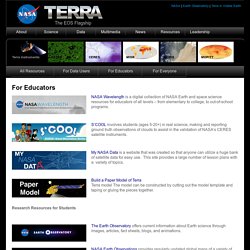
S’COOL involves students (ages 5-20+) in real science, making and reporting ground truth observations of clouds to assist in the validation of NASA’s CERES satellite instruments. My NASA Data is a website that was created so that anyone can utilize a huge bank of satellite data for easy use. This site provides a large number of lesson plans with a variety of topics. Build a Paper Model of Terra Terra model The model can be constructed by cutting out the model template and taping or gluing the pieces together.
Research Resources for Students The Earth Observatory offers current information about Earth science through images, articles, fact sheets, blogs, and animations. NASA Earth Observations provides regularly updated global maps of a variety of measurements from Terra instruments, along with a simple analysis tool.
Basic Graphing Skills. Related quantitative concepts: Understanding trends, Interpolation/Extrapolation, Functions, Graph Significance, Graphing confusionRelated quantitative concepts: Understanding trends, Interpola or skills we should have learned in high school by Jennifer M.
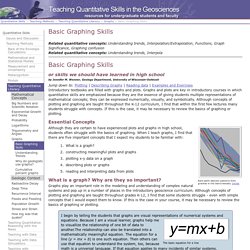
Wenner, Geology Department, University of Wisconsin-OshkoshJump down to:Plotting | Describing Graphs | Reading data | Examples and Exercises Introductory textbooks are filled with graphs and plots. Graphs and plots are key in introductory courses in which quantitative skills are emphasized because they are the essence of giving students multiple representations of mathematical concepts; they can be expressed numerically, visually, and symbolically. Essential Concepts Rare-earth element patterns from granites in the Sierra Nevada. Although they are certain to have experienced plots and graphs in high school, students often struggle with the basics of graphing. What is a graph? What is a graph? The basic equation for a line Plotting data. Earth Learning Idea (ELI)
Astronomy. Geologic Time and Bedrock Geology. Helena field trip. Water resources. NOS - Earth Science. Glaciers. Rocks. Minerals. Volcanoes. Earthquakes. Cartography. Intriguing Questions. Astronomy. Plate Tectonics. Soil. General. Weather. Climate Change. Climate. 160.5.144.40/earthlearningidea/PDF/141_Age_Earth.pdf. Web.ics.purdue.edu/~braile/indexlinks/educ.htm. Ejse.southwestern.edu/article/viewFile/7770/5537.